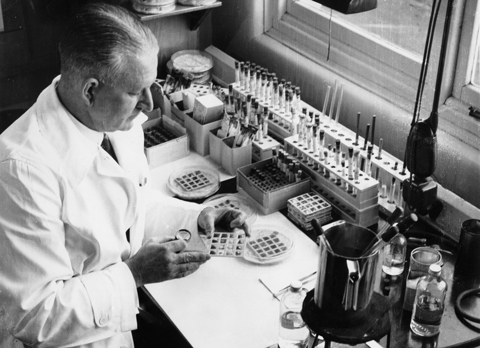Today anti-D injections for the 17 per cent of pregnant women who are Rh D negative are just a regular part of obstetric care in Australia.
However, as recently as 50 years ago, many Australian babies were still developing Rh D haemolytic disease of the fetus and newborn (HDFN) due to incompatible antibodies between mother and baby. These antibodies develop when an Rh D positive baby's red blood cells, which carry the Rh D antigen, escape into the mother’s circulation. These cells are seen as ‘foreign’ by the mother’s immune system and can cause her to make an antibody against them. This antibody, anti-D, can break down the red blood cells of any future Rh D positive babies that the mother might have, resulting in serious anaemia, brain damage or death of the baby.
In 1967, Australia began the pioneering Rh Program. This provided plasma collected from blood donors with anti-D for production of anti-D immunoglobulin for treatment of Rh D negative women with babies at risk of HDFN. Landmark clinical trials in the 1960s had shown that an Rh D negative person could be prevented from forming antibodies to Rh D positive red cells if they were given injections of plasma which contained anti-D. The anti-D is thought to ‘mop up’ the Rh D positive red cells in the circulation, preventing the immune system from recognising them and making their own anti-D antibody.
The lives of countless babies have been saved by the Rh Program since it began 50 years ago. To date, over three million doses of anti-D have been given to Rh negative women. Clinicians now rarely have to manage an affected pregnancy, whereas HDFN once resulted in around 250 stillbirths and deaths every year in Australia and countless more babies with lifelong disabilities.
Interestingly, the discovery of anti-D’s role in preventing HDFN has an important Australian connection. The two international groups which performed the clinical trials came from England and the United States and included John Gorman, a Bendigo doctor and scientist. It was John’s faith in the clinical trial results showing the protective effect of anti-D in male volunteers that led him to provide his sister-in-law, Kath Gorman, who was Rh D negative and pregnant with an Rh D positive baby, with an anti-D injection. Kath became the first woman in the world to receive anti-D. She went on to have seven children with the protection of anti-D injections in each pregnancy.
Within two years of commencement of the Rh Program, in 1969, Australia became the first country to provide anti-D immunoglobulin, free of charge, to every pregnant Rh D negative woman in need.
James Harrison, one of the founding donors of the Rh Program in NSW, had developed his anti-D following the transfusion of 13 units of blood during an emergency lung operation when he was 14 years old. Now nearly 80, James has donated conscientiously for the last 50 years giving over 1,150 donations, making him Australia’s leading donor. His plasma has contributed to every batch of anti-D. He is one of the many quiet heroes who give so generously to this vital program.
“It makes you feel good to help a fellow human, and it’s something that I can do, so I do it,” he says.
James’ daughter is amongst those to have received anti-D; James’ grandchildren may not be alive today if not for his dedication and that of the small group of donors who have been part of the Rh Program.
There are currently about 130 generous Australians contributing to the Program, many of whom donate plasma every two weeks. To maintain their anti-D levels, they receive regular boosting injections of extensively screened and carefully matched Rh D positive cells. The donors who provide these ‘boosting’ red cells are also a vital part of the Rh Program.
New technologies, such as DNA testing to determine the Rh D type of an unborn baby (which has been developed in Australia by Blood Service researcher Dr Cate Hyland), may be used in future to ensure that anti-D is only given when the baby is Rh D positive; however, there is currently no viable alternative for anti-D, so our need for anti-D donors continues.
According to Robyn Barlow, Rh Program Co-ordinator from 1967 to 2006, the whole of Australia owes these donors a big thank you.
“These are amazing, remarkable men and women — and we can never thank them enough.”

